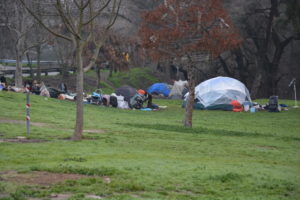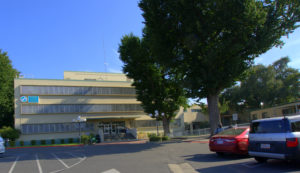
Mired for years in serial meetings, over analysis, and inaction, Stanislaus County’s “Focus on Prevention” leaders finally came forward with a proposal to establish a transitional living center for homeless people last week. There was an immediate public outcry.
The proposed location, on Scenic Drive near downtown Modesto, alarmed residents of the nearby La Loma neighborhood. La Loma is just south of the former hospital where the county would temporarily house homeless people who voluntarily seek help.
Spokespersons for La Loma residents say they are already beleaguered by homeless people living in the parks behind their houses. They also experience a daily outpouring of guests from the nearby Modesto Gospel Mission, which allows nighttime use only.
County authorities settled on the Scenic location after another site near the Salvation Army Shelter on Ninth Street was rejected. Cities with large homeless populations face a constant conflict with nearby residents and business people when they try to establish homeless facilities.
It’s a classic paradox: Everyone wants homeless people off the streets, but no one wants them housed nearby. But La Loma residents, like many frustrated by escalating numbers of homeless people, can’t really be accused of NIMBYism, at least not the narrow definition. NIMBYism is when residents don’t want a project, people, or institution in the neighborhood.
In the case of La Loma homeowners, homeless people are already in the neighborhood and residents are afraid a facility offering services will attract even more. And when La Loma residents say homeless people are already in the neighborhood, they can also claim they’re even in their back yards, at least some of the time.
Most of the time, though, homeless people who frequent the area are on the streets and in the parks along Dry Creek, the charming little 0ak-lined brook that gives the La Loma neighborhood much of its character. The parks themselves, Kewin, Moose, Thousand Oaks and La Loma, offer plenty of nooks and crannies for homeless people to set up camp and the oak canopy provides cooling shade during the hot summers.
Opponents of the Scenic location say the presence of homeless people lowers property values, especially in upscale neighborhoods like La Loma. And while most homeless people are docile and even vulnerable, some are scary and violently demonstrative.

Authorities estimate that a third or more homeless people are seriously mentally ill. When mentally ill people use drugs—cheap and readily available everywhere—their illness is exacerbated and they are far more likely to be violent and unpredictable.
But there’s an almost deliberate avoidance of addressing mental illness by local authorities. Political leaders, law enforcement officials, and even many outreach workers tend to frame homelessness in terms of getting people “on their feet” and “back into the workplace.”
The fact is, a very large proportion of those people on the streets who are violent and scary need professional help. Many have been bounced in and out of temporary “holds” and short-term jail stays for years. They’re the homeless people who “choose” to be homeless, mostly because their decisions are driven by their illness.
Experts in the field agree by a large consensus that seriously mentally ill people need long-term care supervised by qualified medical professionals. No service that operates on the premise of “transition to the mainstream” will keep them off the streets for very long; they are just too ill to be mainstreamed.
For residents of neighborhoods like La Loma, the real question should be about what it will take to bring lasting solutions to homelessness. A big first step would be to acknowledge there are different factors involved in homelessness, and to begin tackling them one by one.
It’s a first step that can’t be taken until citizens admit the magnitude, scope, and costs of dealing with a problem that developed over decades of neglect. It won’t be solved without enough political will to accept a holistic approach that involves health care, housing, jobs, and, most especially, facing facts.
Modesto’s Scenic location, a former hospital, is an ideal place to house mentally ill people who would have to be restricted to the hospital grounds and under constant supervision. As things now stand, those are the people most in need and most likely to be creating problems. They’re also the people least likely to be receiving help.

For folks who want more information and perhaps attend the next BOS meeting on 8/28 this item will be on the agenda for discussion. A reference document for this item can be found here: http://www.stancounty.com/bos/agenda/2018/20180828/DIS02.pdf.
Good article, Eric. Any word on who’ll be running the scenic shelter?
Hi Chris: Good to hear from you. As far as I know, no word yet about operating the shelter. If it were up to me, the Scenic location would be for the seriously mentally ill and under the supervision of Lonny Davis. Don’t think it will happen though.
As a response to California’s failure to decrease homelessness, Governor Jerry Brown signed SB 1380 the “Homeless Coordinating and Financing Council” into law in 2016, officially making California a “Housing First” state and establishing a Homeless Coordinating and Financing Council. This law requires that all state funding for homeless programs incorporate Housing First into their programs by July 1, 2019.
All funding and new projects must include HOUSING FIRST.
it is not a One Size fits all. There are different types of housing first models that target the diversity in the homeless population. No shelters,
This is a plan to work with State, counties and community to end homelessness.
Canada has an on going “Reaching Home” / Housing First working program.